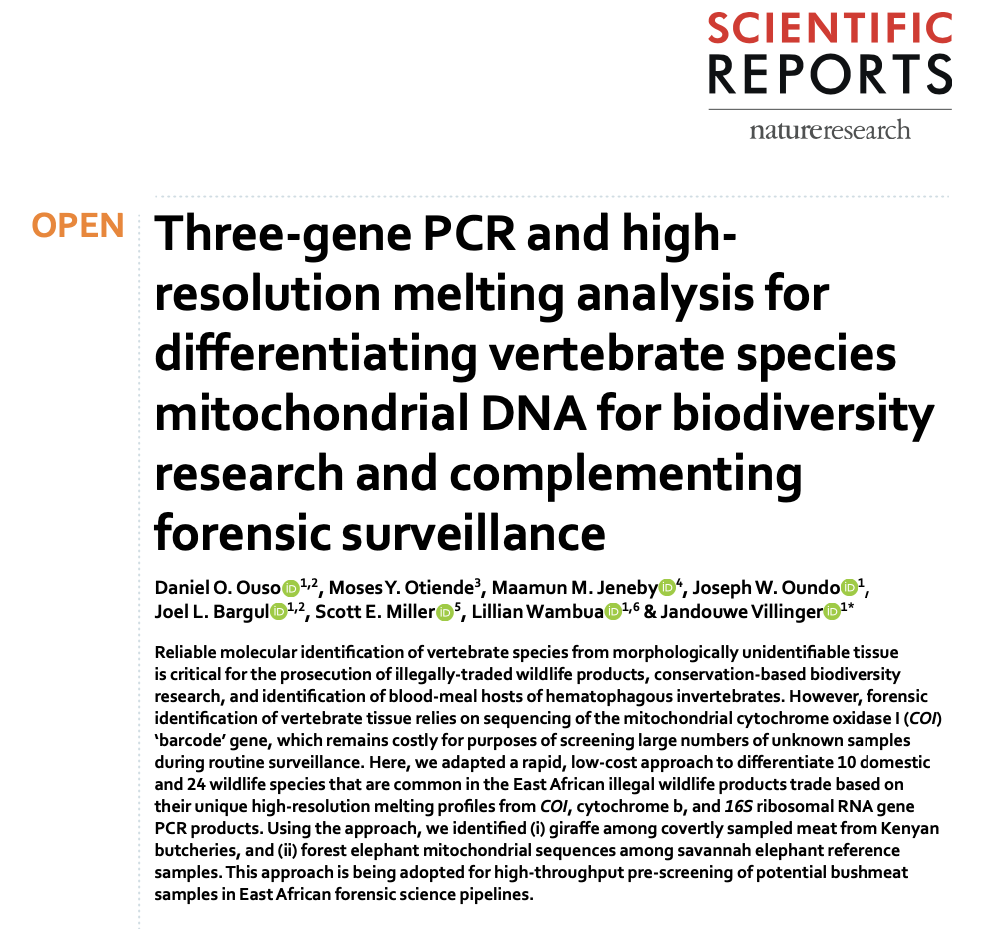Three-gene PCR and high-resolution melting analysis for differentiating vertebrate species mitochondrial DNA for biodiversity research and complementing forensic surveillance
Daniel O. Ouso, Moses Y. Otiende, Maamun M. Jeneby, Joseph W. Oundo, Joel L. Bargul, Scott E. Miller, Lillian Wambua & Jandouwe Villinger
International Centre of Insect Physiology and Ecology (icipe), P.O. Box 30772–00100, Nairobi, Kenya, Biochemistry Department, Jomo Kenyatta University of Agriculture and Technology (JKUAT), P.O. Box 62000–00200, Nairobi, Kenya, Kenya Wildlife Service, Veterinary Department, P.O. Box 40241-00100, Nairobi, Kenya, Institute of Primate Research, National Museums of Kenya, Department of Tropical and Infectious Diseases, P. O. Box 24481-00502, Karen, Nairobi, Kenya, National Museum of Natural History, Smithsonian Institution, Washington, DC, USA, International Livestock Research Institute, Department of Animal Biosciences, P.O. Box 30709-00100, Nairobi, Kenya|2020|Scientific Reports| 10:4741 https://doi.org/10.1038/s41598-020-61600-3
Illegal wildlife trade, including sale and consumption of bushmeat, leads to a significant decline of threatened wild animal species in Africa. Another consequence of illegal wildlife trade is the transmission of diseases that can cause serious health and economic concern. The ability to detect and prevent illegal wildlife trade requires accurate and efficient tools for species identification of confiscated and surveillance samples. The current testing that utilises DNA barcoding of cytochrome c oxidase I (COI) is costly when compared to standard PCR. To address this, a rapid, highly sensitive and cost-effective high-resolution melting (HRM) analysis-based approach was developed in this study. An HRM assay was developed on the Mic qPCR Cycler to differentiate 10 domestic and 24 wildlife species that are common in the East African illegal wildlife products trade from short mitochondrial COI, cytochrome b and 16S ribosomal RNA gene. All three HRM profiles of individual markers were combined to be able to characterise species. Mic’s first-class temperature uniformity can easily distinguish between small differences in Tm, as such in this study (<1°C). The assay was validated by blindly identifying illegal giraffe bushmeat among meat samples purchased from rural and urban butcheries. This was further confirmed by the gold standard forensic barcode sequencing. Therefore, the HRM assay presented in the study represents a valuable complement to molecular forensic pipelines for the surveillance of illegal wildlife products as it eliminates the need for mass barcode sequencing of suspect specimens.
